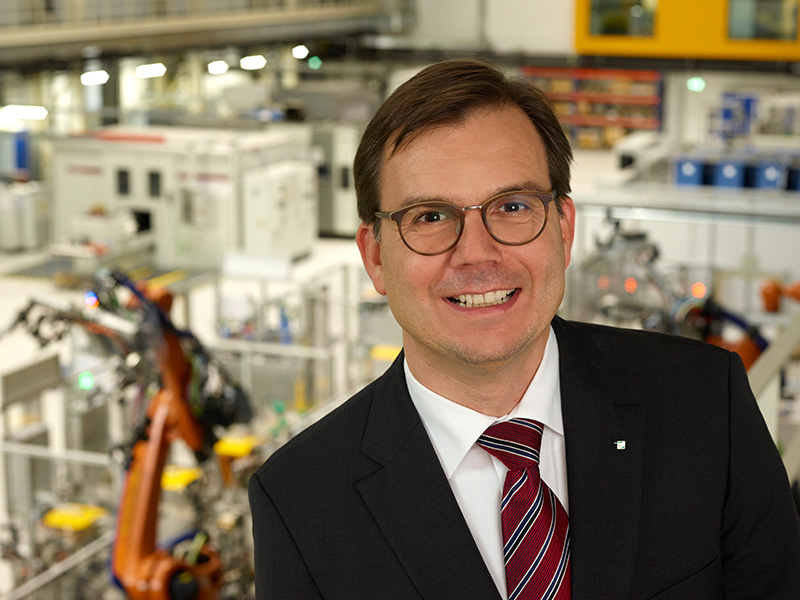Increasing Productivity by Taking a Holistic View of Value Chains
Eleven questions for Prof. Dr. Dirk Landgrebe, Professor for Forming and Joining since October 2014
-

Prof. Dr. Dirk Landgrebe deals with industrial forming and joining methods in research and teaching, that is, the targeted plastic modification of metals and other materials: “The main area of application is the automotive production, but there are also many interesting opportunities in other industries.“ Photo: Fraunhofer IWU/Ines Escherich
Prof. Dr. Dirk Landgrebe (49) holds the Professorship of Forming and Joining at the Faculty of Mechanical Engineering since October 2014. In eleven responses he gives the readers of “University News“ an insight into his professional background, scientific objectives and activities in Chemnitz.
What is actually meant by “forming and joining”?
Forming and joining are manufacturing processes of metal products, but also of materials such as wood, plastic, ceramic, and composites. Forming deals with the mechanical reshaping of raw materials without adding or removing material and without changing its mass. Joining refers to the permanent connection of at least two components. Our main field of research is aimed at industrial automotive production, but there are also interesting applications in other industries.
The TU Chemnitz is the right choice for me as a professor, because…
…although it is small and manageable, this university has an excellent reputation and is very effectively established due to its close cooperation with the Fraunhofer-Institutes as well as the almost familial link with the regional economy and local politics. In addition, the employees of this region demonstrate much dedication and innovation, so it is a joy to work here.
Can you say a few words about your academic career so far?
To start with, I studied Mechanical Engineering in 1987 with a focus on Manufacturing Technology and Production Logistics at the University of Hannover. After graduating, I joined the University of the Federal Armed Forces in Hamburg (now “Helmut-Schmidt-University”) as a research assistant. In 1999, I left Hamburg to take up a position as head of research and development at the Hirschvogel Automotive Group in Upper Bavaria. In January 2000, I finished my PhD, entitled “Determination of Forming Limits via Ductile Material Failure in Cold Forming Processes with the Aid of FEM”.
Describe your years of study in only a few words.
Up until my intermediate exams is a long black hole, afterwards – fascination in all areas.
Did you have role models during your studies who encouraged you to pursue a scientific career?
Yes, Prof. Dr.-Ing. Hans-Kurt Tönshoff – former head of the Institute for Manufacturing Technology and Machine Tools at the University of Hannover. He also made it possible for me to conduct research for a semester at MIT in Boston.
Do you have any advice for young students and graduates?
Don’t just use your period of study for technical qualifications alone. Start searching early on for ways to develop your personality, and motivate young people who are still looking for direction to study in one of the STEM (German: MINT) subjects.
What would you like to achieve in your teachings in the future?
My goal is to use my influence to elevate the quality of mechanical engineering studies at the TU Chemnitz, so that potential students who want to study in one of the STEM subjects definitely have the TU Chemnitz on their list of choices to consider. I’m confident that the TU Chemnitz must refine its image though excellence and well-coordinated study programs. Then, the industry will be even more aware of the TU Chemnitz.
What impact does your research have at the TU Chemnitz?
I want to put a greater focus on the holistic view of value chains that involve forming or joining techniques. Each optimization of the individual components always entails an overall consideration of the total cost of ownership, so that the whole system has to be considered. My main focus is set on massive forming.
There are around 45,000 professors at German universities. What distinguishes you from all others?
I have a long and intensive history of experience in the industry and I stand out because of my close connection to the Fraunhofer IWU. This can be very useful for students and public research funding bodies, but also for industry partners. Professionally, I come from the field of forging and thus distinguish myself clearly from my colleagues.
What is your favorite place to show guests in Chemnitz?
For first-time visitors to Chemnitz, the contrast on the Straße der Nationen between the flair of the Opera House and the Karl-Marx monument is often impressive. Then, you can discover the downtown atmosphere in the area around the Roter Turm and the old and new City Hall. When there’s enough time, we like to go out to the Rabenstein Castle.
How do you play a part in the life of the city?
I’m new in Chemnitz, but I have already had very positive experiences with the extensive cultural offerings of the city. I love music and art and can imagine helping with organization in the future.
Further information about the professorship at: https://www.tu-chemnitz.de/mb/UFF
(Translation: Nataliia Boiko and Sarah Wilson)
Katharina Thehos
17.06.2015





